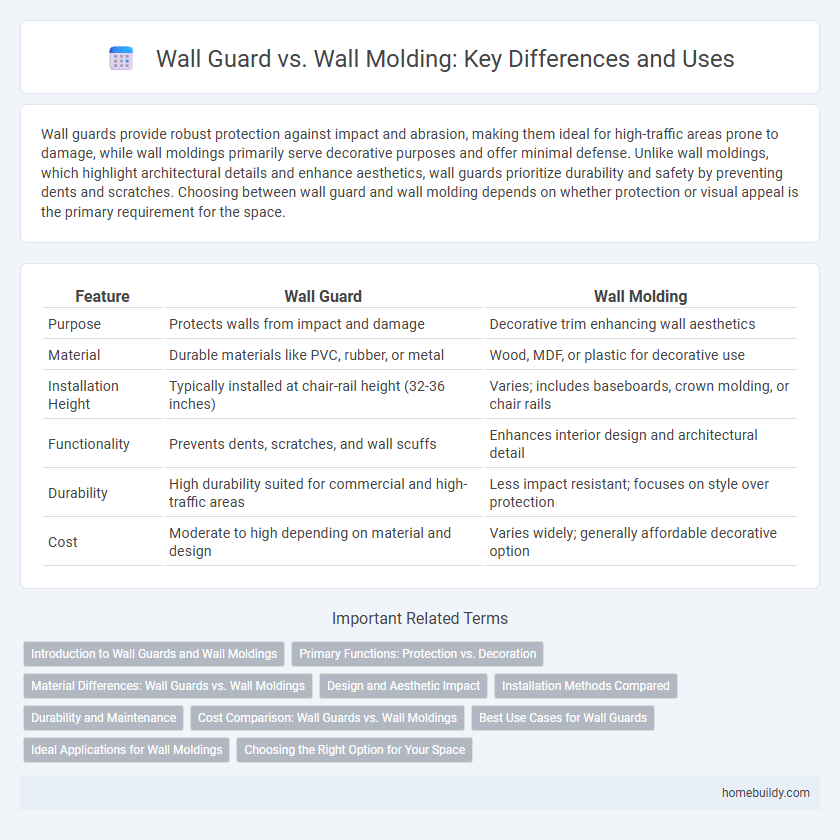Wall guards provide robust protection against impact and abrasion, making them ideal for high-traffic areas prone to damage, while wall moldings primarily serve decorative purposes and offer minimal defense. Unlike wall moldings, which highlight architectural details and enhance aesthetics, wall guards prioritize durability and safety by preventing dents and scratches. Choosing between wall guard and wall molding depends on whether protection or visual appeal is the primary requirement for the space.
Table of Comparison
| Feature | Wall Guard | Wall Molding |
|---|---|---|
| Purpose | Protects walls from impact and damage | Decorative trim enhancing wall aesthetics |
| Material | Durable materials like PVC, rubber, or metal | Wood, MDF, or plastic for decorative use |
| Installation Height | Typically installed at chair-rail height (32-36 inches) | Varies; includes baseboards, crown molding, or chair rails |
| Functionality | Prevents dents, scratches, and wall scuffs | Enhances interior design and architectural detail |
| Durability | High durability suited for commercial and high-traffic areas | Less impact resistant; focuses on style over protection |
| Cost | Moderate to high depending on material and design | Varies widely; generally affordable decorative option |
Introduction to Wall Guards and Wall Moldings
Wall guards are protective fixtures designed to prevent damage to walls in high-traffic areas, commonly used in commercial buildings, hospitals, and schools. In contrast, wall moldings serve primarily decorative purposes, enhancing architectural aesthetics by adding texture and defining transitions between wall surfaces. Understanding the functional differences between wall guards, made of durable materials like rubber or vinyl, and wall moldings, often crafted from wood or plaster, is essential for selecting the appropriate solution for wall protection or design enhancement.
Primary Functions: Protection vs. Decoration
Wall guards primarily serve to protect walls from damage caused by impacts, scratches, and daily wear, making them essential in high-traffic areas like hospitals and commercial buildings. In contrast, wall moldings focus on decorative enhancements, adding architectural detail and aesthetic appeal to interior spaces. The functional distinction highlights wall guards' role in durability and maintenance, whereas wall moldings emphasize style and design.
Material Differences: Wall Guards vs. Wall Moldings
Wall guards are typically constructed from durable materials such as vinyl, rubber, or metal to provide impact resistance and protect walls in high-traffic areas, while wall moldings are often made from wood, MDF, or decorative plastics designed primarily for aesthetic enhancement and minor wall protection. The material choice for wall guards prioritizes strength and durability to withstand frequent contact and potential damage, whereas wall moldings focus on texture, finish, and style to complement interior design. These fundamental differences impact installation, maintenance, and the functional role each product plays in both commercial and residential environments.
Design and Aesthetic Impact
Wall guards provide a functional design element that protects walls from damage while maintaining a streamlined, minimalist appearance suitable for commercial and high-traffic areas. In contrast, wall moldings offer a decorative aesthetic, featuring intricate profiles and varied textures that enhance architectural detail and create visual interest in residential or formal settings. Choosing between a wall guard and wall molding depends on balancing durability needs with the desired style impact within the interior space.
Installation Methods Compared
Wall guard installation typically involves mounting heavy-duty materials like vinyl or rubber directly onto walls using screws, anchors, or adhesive backing to provide durability and impact resistance. Wall molding installation often requires precise cutting and fitting of lighter materials such as wood or PVC, attached with nails or adhesive for decorative or transitional purposes. The wall guard method prioritizes protection and sturdiness, whereas wall molding emphasizes aesthetic appeal and ease of customization.
Durability and Maintenance
Wall guards typically offer superior durability compared to wall moldings due to their robust materials such as high-impact vinyl or aluminum, designed to withstand frequent contact and prevent damage. Maintenance of wall guards is minimal, often requiring only occasional cleaning with mild soap and water, whereas wall moldings can be more susceptible to dents, scratches, and require repainting or touch-ups over time. For environments with high traffic or risk of impact, wall guards provide a long-lasting, low-maintenance solution that enhances wall protection.
Cost Comparison: Wall Guards vs. Wall Moldings
Wall guards typically cost between $20 and $50 per linear foot, offering durable protection against impacts in high-traffic areas. Wall moldings generally range from $10 to $30 per linear foot but provide less robust protection and are primarily decorative. Choosing wall guards over wall moldings can result in higher upfront costs but lower maintenance expenses due to enhanced durability and impact resistance.
Best Use Cases for Wall Guards
Wall guards excel in high-traffic commercial environments where wall protection from impact and abrasion is critical, such as hospitals, schools, and warehouses. Unlike wall molding, which primarily serves decorative or minor protective roles, wall guards provide robust durability and often include materials like vinyl or rubber that absorb shocks and prevent damage. Their best use cases prioritize functionality and safety, effectively preserving wall integrity in demanding settings.
Ideal Applications for Wall Moldings
Wall moldings are ideal for enhancing aesthetic appeal and providing a decorative finish around doors, windows, and ceilings, offering a polished look that complements interior design. They protect walls from minor scratches and dents in low-impact areas but are not designed for heavy-duty protection like wall guards. Ideal for residential spaces and light-traffic commercial environments, wall moldings emphasize style and subtle wall protection rather than robust durability.
Choosing the Right Option for Your Space
Wall guard provides robust protection against impact and scuffs, ideal for high-traffic areas where durability is crucial. Wall molding offers a more decorative approach, enhancing aesthetic appeal while providing minimal protection. Selecting between wall guard and wall molding depends on balancing the need for durability versus design, as well as considering the specific functional demands of your space.
Wall guard vs Wall molding Infographic

 homebuildy.com
homebuildy.com